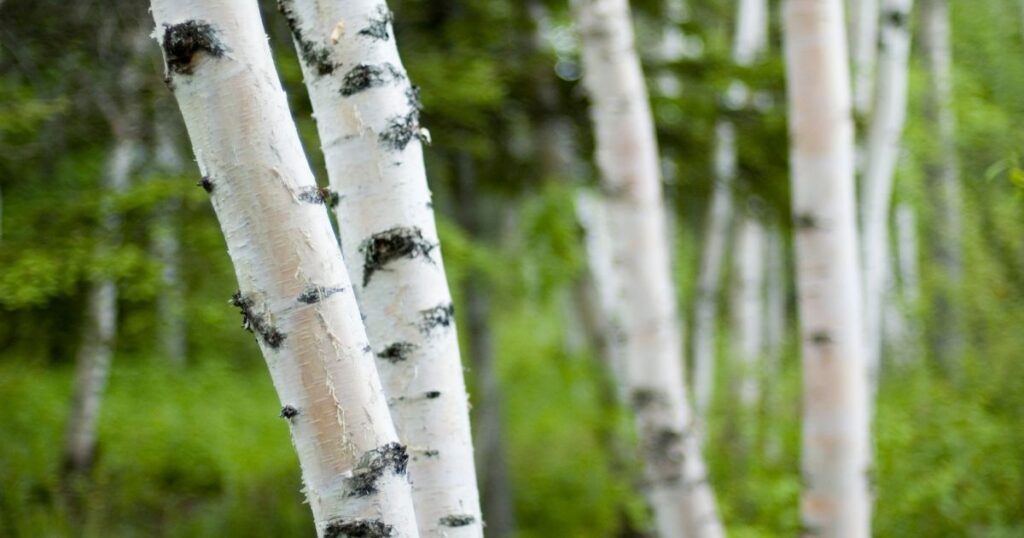Silver Birch Pruning: Ultimate Guide
Silver birch trees are popular for their beautiful bark, delicate leaves, and graceful shape. However, they require proper pruning to maintain their health and appearance.
Pruning silver birch trees involves removing any dead or diseased branches, as well as thinning out the canopy to allow more sunlight to reach the inner branches. This helps to promote healthy growth and prevents the tree from becoming too dense and top-heavy.
One important thing to keep in mind when pruning silver birch trees is that they are susceptible to bleeding. This means that if you prune them during the wrong time of the year, they may bleed sap excessively, which can weaken the tree and make it more susceptible to disease.
So, how do you prune a silver birch tree? And when is the right time to do so?
In this guide, we cover everything you need to know before you start pruning.
So, let’s dive in.
If you need help pruning your tree, get in touch with the experts at Evolution Tree Surgery. We’re on hand to help with all aspects of tree pruning, crown reduction, crown lifting, and crown thinning in Newbury, Berkshire and the surrounding areas.
If you’d like a free quote, call us at 07917 195806 or complete our online enquiry form.
What is a Silver Birch?
The silver birch, scientifically known as Betula pendula, is a tree belonging to the Betulaceae family. It is commonly referred to as warty birch, European white birch, or East Asian white birch.
Native to Europe and parts of Asia, it is also found in Siberia, China, and southwest Asia. In North America, it is known as the European white birch or weeping birch and is considered invasive in some regions.
The silver birch has also been introduced into more temperate areas of Australia. It is characterised by its distinctive silvery-white bark and is known for its ornamental value in landscaping.

When is the Best Time to Prune a Silver Birch Tree?
The best time to prune a silver birch tree is during the dormant season, which usually falls in late autumn or winter. Pruning during this period helps minimise sap loss and lowers the risk of disease or pest infestation.
It also allows the tree to allocate its energy towards healing and new growth when spring arrives. However, if there are specific issues such as dead or diseased branches, they can be pruned at any time of the year to prevent further damage to the tree.
Tools and Equipment You Need to Prune
The following are some of the tools that are essential for pruning silver birch trees:
- Pruning shears: These are used for cutting branches that are less than 1 inch in diameter.
- Loppers: These are used for cutting branches that are between 1 and 2 inches in diameter.
- Pruning saw: This is used for cutting branches that are more than 2 inches in diameter.
- Pole pruner: This is used for pruning branches that are high up in the tree.
The following are some tips to ensure safety when pruning:
- Wear protective gear, such as gloves and safety glasses.
- Use a ladder that is stable and secure.
- Do not prune near power lines.
- Do not prune during windy or wet weather.
Step-by-Step Silver Birch Pruning Guide
Pruning silver birch trees can help maintain the tree’s shape, encourage healthy growth, and prevent disease.
Here is a step-by-step guide to pruning silver birch trees:
- Choose the right time: The best time to prune a silver birch tree is in late winter or early spring before new growth begins. This is because the tree is still dormant and pruning at this time will encourage new growth.
- Start with dead and diseased wood: Begin by removing any dead or diseased wood. This will prevent the spread of disease and help the tree focus its energy on healthy growth.
- Remove crossing branches: Look for branches that are crossing or rubbing against each other. These branches can cause damage and should be removed.
- Thin out the canopy: To improve air circulation and sunlight penetration, thin out the canopy by removing some of the smaller branches. This will also help maintain the tree’s shape.
- Cut back long branches: If any branches are too long, cut them back to a healthy lateral branch. This will help maintain the tree’s shape and prevent it from becoming too tall.
- Use proper pruning techniques: Always use sharp, clean tools and make clean cuts. Avoid leaving stubs or tearing the bark.

Pruning Techniques
Formative Pruning
Formative pruning is the process of shaping young silver birch trees to develop a strong and healthy structure. This pruning technique is usually done during the first three years of the tree’s life. The aim is to create a well-balanced tree that can withstand harsh weather conditions and resist diseases.
During formative pruning, the following steps should be taken:
- Remove any damaged, diseased or crossing branches.
- Cut back the leading shoot to a bud that is facing in the desired direction.
- Remove any branches that are growing too close to the trunk.
Maintenance Pruning
Maintenance pruning is done on mature silver birch trees to keep them in good health and shape. This type of pruning is done annually and involves removing dead, diseased, and crossing branches.
During maintenance pruning, the following steps should be taken:
- Remove any dead, diseased or crossing branches.
- Cut back any branches that are growing too long and out of shape.
- Thin out any overcrowded branches to allow more light and air to circulate.
Rejuvenative Pruning
Rejuvenative pruning is done on mature silver birch trees that have become too large or overgrown. This type of pruning involves removing a significant amount of the tree’s canopy to encourage new growth.
During rejuvenative pruning, the following steps should be taken:
- Remove up to one-third of the tree’s canopy.
- Cut back any remaining branches to a healthy bud or lateral branch.
- Remove any dead or diseased wood.
It is important to note that rejuvenative pruning should only be done on healthy trees that have the potential to recover. If a tree is in poor health, it may not survive the shock of rejuvenative pruning.
Common Pruning Mistakes
Improper pruning techniques can lead to damage and even death of the tree.
Here are some common pruning mistakes to avoid:
Over-Pruning
Over-pruning is a common mistake that can weaken the tree and make it more susceptible to disease and pests. Pruning more than one-third of the tree’s crown in a single season can lead to stress and damage, so it’s important to avoid excessive pruning.
Improper Cutting Technique
Improper cutting techniques can also cause damage to the tree. Cutting too close to the trunk, leaving a stub or making a jagged cut can make the tree vulnerable to infection and decay. It’s important to use sharp, clean pruning tools and make clean, angled cuts to promote healing.
Neglecting Tool Hygiene
Neglecting tool hygiene can also be a problem when pruning silver birch trees. Dirty tools can spread disease and pests from one tree to another, so it’s important to clean pruning tools with a disinfectant after each use. This will help prevent the spread of disease and ensure the health of your trees.

Need Help Pruning Your Silver Birch Tree?
During the growing season, particularly in late summer, it’s essential to monitor silver birch, river birch, paper birch, and Himalayan birch trees for signs of diseases, especially fungal infections. Look out for white pustules, dead branches, and dead wood, which may indicate the presence of fungal diseases.
To maintain the health of these deciduous trees, it’s good practice to prune dead or diseased branches in early summer or early autumn using the right tools and techniques to avoid causing an open wound.
For the best results and to prevent the spread of diseases, consider consulting a qualified tree surgeon, who can assess the tree’s condition, provide an obligation-free quotation, and perform the necessary pruning while preserving the branch collar. These versatile trees thrive in full sun and require deep roots, but be vigilant for weed growth and consult tree surgeons for expert care.
So, if you’re looking to give your silver birch tree the best care possible, consider reaching out to a qualified tree surgeon.
At Evolution Tree Surgery, we offer tree pruning for residential and commercial customers in Newbury and the surrounding areas in Berkshire.
For a free tree pruning quote, call Evolution Tree Surgery in Newbury at 07917 195806 .
Frequently Asked Questions
What is the best season to prune a silver birch in the UK?
The best time to prune a silver birch in the UK is during the dormant season, which is between late autumn and early spring. Pruning during this period reduces the risk of disease and insect infestations. However, avoid pruning during the coldest winter months, as the tree may not be able to recover from the damage caused by the pruning.
How can I manage the height of a silver birch without causing harm?
To manage the height of a silver birch without causing harm, it is recommended to practice crown reduction. This involves removing the top branches of the tree to reduce its height. However, it is important to note that this should only be done by a professional arborist, as improper pruning can harm the tree.
Is it possible to reduce the height of a birch tree by topping?
Topping, which involves removing the top of the tree, is not recommended for silver birch trees. This is because it damages the tree and can lead to decay and disease. Instead, crown reduction is the recommended method for reducing the height of a silver birch tree.
What are the implications of heavy pruning on a silver birch’s health?
Heavy pruning can have negative implications on a silver birch’s health, as it can lead to stress and damage to the tree. It is important to only prune what is necessary and to avoid removing more than 25% of the tree’s canopy. This will ensure that the tree remains healthy and can recover from the pruning.
How often should silver birch trees be pruned for optimal health?
Silver birch trees should only be pruned when necessary, such as to remove dead or damaged branches, or to manage the tree’s height. It is not recommended to prune the tree on a regular schedule, as this can harm the tree and reduce its lifespan.
What are the typical costs associated with professional silver birch pruning services?
The cost of professional silver birch pruning services can vary depending on the size of the tree, the extent of the pruning required, and the location of the tree. On average, the cost can range from £150 to £500 per tree. It is recommended to obtain quotes from several reputable arborists to ensure a fair price.
Related Guides & Advice:
- How to Prune an Apple Tree
- Essential Types of Tree Pruning Techniques
- When to Prune a Magnolia Tree
- How Much Does Tree Surgery Cost?
- What is Tree Felling?
- What is a Tree Surgeon?
- When is the Best Time to Cut Trees Back
- How to Choose a Tree Surgeon
- Our Hedge Removal Guide
- Common Types & Symptoms of Tree Disease
- Best Time to Cut Conifers for Healthy Growth

